Multi-colored markings may appear on Russian roads
Previously, GOST provided only three colors for road markings: white for most types of markings, yellow for places where stopping or parking is prohibited, orange for temporary markings.
Now permanent markings, which previously were only white or yellow, can be in other colors: red, blue, green and even black.
The point of such innovations is to separate marking lines that are more important for safety from those that are less important. For example, markings that indicate lanes within an intersection may now be blue. The same color can be used to mark the boundaries of parking spaces.
According to the new GOST, yellow will be used to indicate those zones where overtaking is prohibited.
The new markings on Russian roads, which are regulated by the GOST standard that came into force on June 1, 2021, will be more informative precisely due to the color variety. However, drivers do not have to learn when to use blue markings and when to use green markings. The lines themselves will remain the same, they mean the same as before, so the main thing is the form of the marking.
Yellow with a blue stripe: what kind of cars did USSR traffic cops drive?
Traffic was regulated by special people back in the days of carriages, and with the spread of cars in different countries, special structures began to appear. In the USSR it was called the State Traffic Inspectorate, the date of its creation is considered to be July 3, 1936; Before that, the traffic control department of ORUD was responsible for order on the road. And at first, employees of the state automobile inspection patrolled the streets not in cars at all...
The first transport of traffic cops is motorcycles
The traffic controllers who existed before the creation of the traffic police in 1936 mainly used bicycles and motorcycles. And the last method of transportation remained the main one for employees for many years. The main task of the ORUD was to pursue troublemakers on the roads, which at that time were very few in number.
The traffic cops already had broader powers: the traffic police with bodies in the union and autonomous republics was created “in order to decisively combat the misuse and predatory attitude towards road transport in all departments and organizations of the USSR.” Her interests included combating accidents and analyzing their causes, developing technical standards for the operation of transport and its accounting, monitoring the training and education of drivers, and searching for cars. But the traffic police fleet consists almost exclusively of motorcycles, and not only ordinary employees, but also superiors travel on such vehicles.
Until the 1950s - GAZ M-1 and GAZ-67B
After the end of World War II, the Soviet State Traffic Inspectorate received captured and demobilized cars: these were GAZ M-1 and GAZ-67B, but there were very few of them.
1950s - specialized traffic police cars and their colors
In the middle of the last century, the traffic police began to use civilian “Victory”, modified for the needs of the traffic police. A great feature of the company cars were the loudspeakers on the roof. Also in the post-war years, the USSR Ministry of Internal Affairs began developing a special color scheme that would highlight police cars in the growing traffic flow. One of the first solutions was red stripes on the sides. In 1954 they tried to paint the cars dark blue with a red stripe, and in 1962 they tried on a blue body.
Volga GAZ-21 began to be used by the traffic police in the late 1950s, and the engine of service vehicles was boosted from 70 to 85 hp. The coat of arms of the USSR was depicted on the doors of the Volga.
In the 1960s, the traffic police acquired Moskvich-400 and GAZ-69, as well as UAZ vehicles. And in 1968, police cars began to be painted yellow with a blue stripe on the sides. The standard was developed by an entire research institute - namely VNIITE together with VNIINmash of the USSR State Standard, which used data from Soviet and foreign research and carried out full-scale tests in traffic.
1970s – mass-produced Zhiguli cars
As the fleet of the great country grows, so does the fleet of those who control the traffic flow. Moreover, the main Russian automobile plant has a mass model - the VAZ-2101. For the needs of the State Traffic Inspectorate, the “kopecks” were increased. Also during these years, traffic cops drove Volga GAZ-24s.
1990s – white and blue Samaras
After the collapse of the USSR, it was decided to change the design of traffic police cars - now patrol cars are painted white with blue stripes.
We try to collect the most useful information for car enthusiasts from all over Russia and the world, and these photographic materials are just one of them.
Be sure to share your thoughts in the comments below.
New types of markings from June 1, 2021
But what is really worth paying attention to is the new types of markup.
Firstly, this is a “waffle iron” marking that few people are familiar with in practice, but is increasingly being implemented (drivers of the largest cities in the country are already familiar with it). With the help of this marking, an intersection of roadways is indicated where you cannot be present during the prohibitory phase of the traffic light.
The essence of this marking is that it prevents the formation of congestion at intersections. The driver, even if there is no such marking, should not enter the intersection if there is a traffic jam on it or immediately behind it. When the traffic light changes from green to red, the driver's car may remain at the intersection. which will interfere with movement from the transverse direction.
This, even without the “waffle iron” markings, was considered a traffic violation and was punishable by a fine. But in practice, such fines were issued extremely rarely.
The “waffle iron” marking will automate this process. Where it will be applied, cameras will most often be installed to photograph violations, which will detect violators and automatically issue them fines.
The second new thing you need to know about is the markings that indicate the place or area for a turn. It will look like an arrow on the corresponding sign and will no longer confuse drivers. The fact is that turning left is prohibited in places for turning around, but the markings in such places were carried out precisely as a left arrow. Of course, drivers should follow the signs, but the markings are often misleading in such situations.
Now, in places for turning around, the markings will clearly indicate that in this place it is only allowed to turn around, but turning left is not possible.
When will the new road markings become widespread?
It's impossible to say for sure. In some cities it may not appear very soon. The thing is that road GOSTs have been of a recommended or voluntary nature for many years. This means that the new GOST is a certain guideline for road services, but they are not obliged to follow it.
But even where city services decide to use the new GOST right now, its implementation will take some time due to the peculiarities of the bureaucracy in the country.
A simple example of how this happens in Moscow (in other regions the procedure will be similar):
- a traffic organization project is being prepared,
- the project is approved by the Department of Transport,
- the project is sent to the housing and communal services department,
- the housing and communal services department sends the project to the executors - directly to the road services,
- new markings are applied during scheduled work.
Thus, it is not a fact that in 2021 new markings will appear on Russian roads at all. With the exception, of course, of the “waffle iron,” which helps replenish the budget through fines.
Legal formalities and reality
The new road regulations formally come into force on June 1, but the current order of the Russian government dated November 4 refers to the old GOST. A similar reference to the same old GOST is contained in the current Traffic Rules. Thus, an obvious contradiction arises between various regulatory documents. Officials say that until all these legal conflicts are resolved, the use of both old and new types of road markings is allowed.
In addition, there are many administrative and technical obstacles that slow down the application of the new GOST. For example, in Moscow, the corresponding changes must be approved by the city departments of transport and housing and communal services. Only after this the necessary orders will be transmitted to the contractor (GBU “Highways”). This organization, in turn, will apply new markings to the capital's highways as the asphalt surface is replaced as planned. In other regions of the country the situation is even more complicated. It can be assumed that the process will drag on for several months or even years.
Don't miss: Mortgage refinancing: lowest interest rate
New colors
Now the markings on the road can be of four colors: white, yellow, orange or black (on the so-called “vertical” markings, for example, on bollards, bridge supports, etc.). The new standard adds three new marking colors at once:
- red;
- green;
- blue.
Most likely, the first two will be used to duplicate road signs. But blue color is used for marking 1.7, which marks the boundaries of traffic lanes within the intersection.
In addition, the new GOST allows the use of yellow for the most popular road markings (solid, intermittent, etc.) - it is assumed that yellow markings will be better visible in winter, when there may be snow on the roads.
Public transport stop
1.17
1.17.2
Now public transport stops are marked with marking 1.17, which is a broken yellow line running parallel to the sidewalk. The new marking with index 1.17.2 will also look like a broken line, but it will be applied perpendicular to the sidewalk. It will not be possible to park within the coverage area of the markings (only stopping to pick up or drop off passengers is allowed, and even then if there is no interference with public transport).
From June 1, 2021, a new GOST for road markings will come into force in Russia. It makes significant changes to already adopted standards. In particular, in addition to the usual white and yellow lines, blue markings will appear.
From June 1, 2021, a document entitled “Technical means of organizing traffic will come into force. Road markings. Classification. Technical requirements”, which provides for a new GOST for road markings. Let's look at the main changes.
Blue markings
One of the most important innovations is blue markings. It proposes to carry out elements that have the least impact on safety - traffic lines at intersections, parking spots, etc.
Yellow markings
But the most dangerous places, along with white, are proposed to be marked with yellow markings. We are talking, for example, about a continuous line in zones where overtaking or driving into the oncoming lane is prohibited. The yellow lines are supposed to be more visible to the driver, especially in winter.
Other markup requirements
The new GOST specifies the use of other new types of markings:
- “waffle” markings prohibiting stopping at an intersection;
- designation of places for charging electric vehicles;
- an arrow indicating a turn (previously, markings were used to indicate only a turn);
- two new types of pedestrian crossings.
When will the new markings appear on the roads?
The most interesting thing is that this document introduces new requirements for markings, but does not regulate their application, reports Avtospravochnaya.com. To start using it on the roads, all these changes must be spelled out in the text of the traffic rules, according to which the driver must act. If there are no new markings in the traffic rules, then the driver is not obliged to follow its requirements. And now the current text of the traffic rules generally refers to the previous GOST on markings. Therefore, the markings on the roads are unlikely to change in the near future.
When will the new markings appear on the roads?
The most interesting thing is that this document introduces new requirements for markings, but does not regulate their application, reports Avtospravochnaya.com. To start using it on the roads, all these changes must be spelled out in the text of the traffic rules, according to which the driver must act. If there are no new markings in the traffic rules, then the driver is not obliged to follow its requirements. And now the current text of the traffic rules generally refers to the previous GOST on markings. Therefore, the markings on the roads are unlikely to change in the near future.
New road markings
Tram station
A new type of marking 1.17, indicating stopping places for route vehicles.
Stops for trackless vehicles are indicated by markings 1.17.1 - new marking number 1.17; for tram stops with tracks located in the center of the road, markings 1.17.2 have been added. It is applied on the roadway on both sides, has a width and pitch of 1 meter. Currently not included in the Traffic Rules.
Waffle iron
A new type of road marking 1.26, which has already received the unofficial name “Waffle Iron”.
1.26 (color - yellow) - designates a section of the intersection that is prohibited from entering if there is a traffic jam ahead along the route that will force the driver to stop, creating an obstacle to the movement of vehicles in the transverse direction, with the exception of turning right or left in the cases established by these Rules. The marking can be used independently or in conjunction with road sign 1.35.
Amended to the Traffic Rules from April 28, 2021.
U-turn
Added image of marking 1.18, indicating a turning lane.










